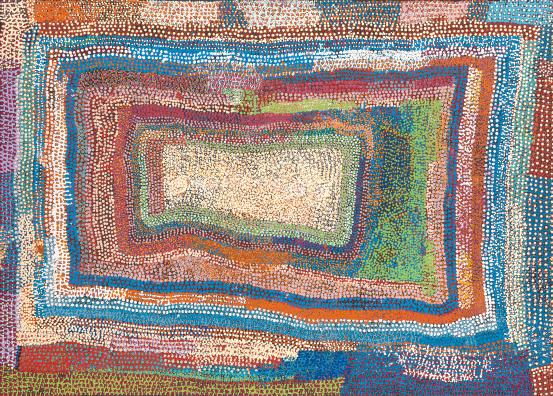
Tommy Mitchell (Ngaanyatjarra born c.1943) – Kurlilypurru, 2009
synthetic polymer paint on canvas – 152.0 x 212.0 cm
© Tommy Mitchell, courtesy Warakurna Artists Aboriginal Corporation
An open-minding, seminal exhibition of contemporary Aboriginal artists from the isolated regions of the Far Western Desert is currently making history at the NGV.
Representing dynamic communities and artists who have emerged during the past decade, Living Water – Contemporary Art of the Far Western Desert is testament to the diversity of styles and freshness that characterize these so far overlooked and little known Aboriginal artists. Highlights include the bold and vibrant use of wide-ranging colours conveying true joy and the spectacular collaborative artworks.
The National Gallery of Victoria, in a deliberate and truly avant-garde move has put the Far Western Desert region and its artists on the map, thus revealing the real colours of today’s Aboriginal art. Breathtakingly beautiful!
Source: Solenne Ducos-Lamotte, IDAIA’s Founder and Director.
RELATED EVENT – Floor talk – Living Water
RELATED GALLERY – View gallery of images related to this exhibition
EXHIBITION BACKGROUND INFORMATION
Living Water, an exhibition showcasing 107 contemporary Indigenous paintings by 94 artists from the Felton Bequest Gift, displays works by male and female artists from the Far Western Desert, an area stretching across parts of Western Australia, South Australia and the Northern Territory.
Aboriginal people from across the Western Desert use the term living water to describe water sources, including rock holes and soakage waters that are fed by underground springs. The path of these springs was created by the ancestral beings of the Tjukurrpa (Dreaming) as they themselves journeyed underground, their entry into the earth often marking the site of current day water sources. Living water is revered also because it does not seem to be affected by the harsh conditions above the ground that the people themselves have to endure.
This exhibition has been curated by Judith Ryan, Indigenous Art Curator, NGV.
The following groups of people are represented in this spectacular exhibition:
Pintupi people
Pintupi is the name of a Western Desert language spoken by Aboriginal people who belong to a large stretch of country in the Gibson Desert of Western Australia and the western edge of the Northern Territory. When the Pintupi arrived in the government settlements east of their traditional lands between the 1930s and the 1950s, they adopted the term ‘Pintupi’ to distinguish themselves amongst the surrounding Aboriginal inhabitants as the ‘people from the west’.
The Pintupi’s complex relationship to the land of their ancestors is expressed through stories, songs and ritual practice that are also depicted in the acrylic paintings of the artists from the Pintupi communities of Walungurru and Kiwirrkura.
Spinifex People
The country of the Spinifex people, who speak a southern dialect of Pitjantjatjara language, consists of vast plains of deep red sand, salt lakes and Spinifex.
In 1998 the community produced a series of ten large paintings that were bequeathed to the people of Western Australia in a symbolic reciprocal exchange of paintings for land. Most Spinifex works, subsequently produced on infrequent painting trips back to country operate as complex maps as well as religious landscapes that detail sources of spiritual power in country belonging to individual artists.
Ngaanyatjarra, Pitjantjatjara and Yankunytjara People
The Ngaanyatjarra, Pitjantjatjara and Yankunytjara people of the tri-state region of the Western Desert constantly interact and are related by kinship, language and genealogy.
Here they specialised in making walka (drawings), batik, punu (wood carvings) and tjanpi weavings, avoiding painting on canvas for the art market until the 21st century because of their suspicion of earlier forms of Western Desert art and their reluctance to disclose sacred elements of men’s and women’s law.
Yulparija People
The Yulparija people originally come from the Great Sandy Desert of Western Australia, which runs from Telfer in the south to Walungurru in the east and close to Fitzroy Crossing in the north.
Their work contains deep threads of cultural memory and is daring in its vigour of application and iridescent palette. The Yulparija have forged a painting style that combines their cultural memory of desert birth country with the rich blues and greens of saltwater terrain.
Martu People
Martu means ‘one of us’, or ‘person’ and is the word chosen to represent a number of different language groups from country across the Great Sandy, Little Sandy and Gibson Deserts of the Pilbara region of Western Australia.
Martu are interconnected to other surrounding peoples from the Great Sandy Desert through their shared country of birth and associated Dreaming stories.
Ngayartu Kujarra
The artists who collaborated on this work live at Punmu community, on the shore of a vast salt lake, (Lake Dora), which is surrounded by a scattered array of water sources.
The artists from this region are profoundly affectionate and respectful towards the salt lake and the fresh waters that have sustained them and their families for as long as memory can stretch.
The women have reproduced the feeling of the salt lake viscerally: their work conveys its immense scale, fine texture, extreme whiteness and shimmering light.
Living Water will be on display at The Ian Potter Centre: NGV Australia from 24 May until late 2011. 10am–5pm, closed Mondays. Free entry.
An exquisite publication Living Water: Contemporary Art of the Far Western Desert has been produced to complement this exhibition and is available from NGV Shop for RRP$14.95 paperback.
Source: NGV media kit.